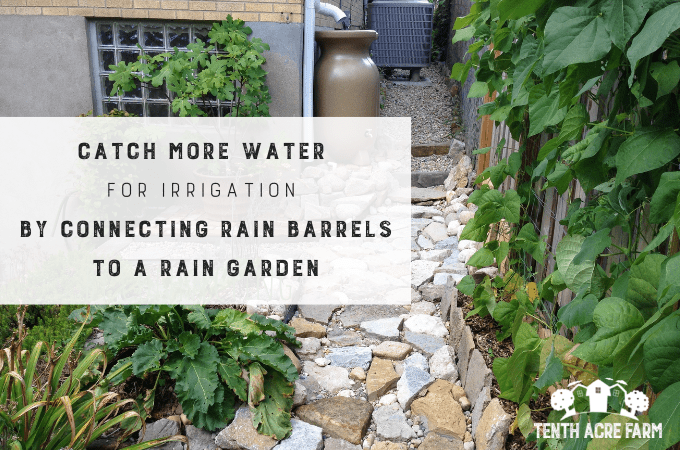Rain barrels can fill up within minutes. By connecting your rain barrels to a rain garden, you can make the most of harvesting rainwater for irrigation.

This page may contain affiliate links. Please read my disclosure for more info.
Why Worry about Rain Barrel Overflow?
Water is powerful: One downspout can fill a 55-gallon rain barrel in less than five minutes!
My 1,200-square-foot roof, for example, can collect an average of 30,525 gallons of rain per year. It’s easy to see that a 55-gallon rain barrel doesn’t catch a lot of water in comparison.
Directing the rain barrel overflow into the landscape, however, is one way to make rain barrels more eco-friendly and useful.
It is important to think about what to do with the excess water, because an overflowing rain barrel can flood a basement, damage a foundation, or worse, do the same to an unsuspecting neighbor downhill.
Directing Rain Barrel Overflow into the Landscape
One of the supposed benefits of rain barrels is their ability to keep water out of the sewer system during a rain event. That’s because stormwater runoff causes soil erosion, can carry pollution, and can overwhelm municipal stormwater systems, sometimes causing raw sewage to enter local waterways.
We can now see that rain barrels on their own don’t keep much water out of the sewer system, but catching water in the landscape will reduce the amount of water that is sent to the municipal stormwater system.
Retaining water on site will benefit the local ecosystem by:
- Recharging groundwater (instead of it being whisked away)
- Filtering pollution
- Reducing surface runoff and soil erosion
- Irrigating downhill gardens
- Creating habitat and microclimates
That is why in our front yard garden we decided to use a swale to capture rainwater from the roof in the landscape. In our backyard, we directed rain barrel overflow into a rain garden.
What is a Rain Garden?
A rain garden is a shallow depression in the ground, usually bowl- or kidney-shaped, with berms on the downhill sides, designed to capture rainwater. The depression is planted with deep-rooted, drought-tolerant native perennials.
In my article How to Build a Rain Garden you’ll learn how to locate the proper site, calculate the size, and get step-by-step instructions.
*Check local regulations for legality. In my city, rain barrel overflow must legally redirect back to the sewer system, while in my county it is legal to send overflow to a rain garden.
Would you like to yield delicious harvests while partnering with nature? Check out my mini guide, The Permaculture Inspired Vegetable Garden.
Our Backyard Rain Barrel-to-Rain Garden System, 1.0
In 2008, we installed a rain barrel-to-rain garden system in our backyard.
This is what our backyard looked like before the work started:

The yard, pre-rain garden in 2008
This narrow strip, just 4-feet wide between the fence and the house, was not serving any purpose. Sun-baked clay soil hosted a number of random and useless plantings from the previous owners.
What struck our attention, though, was how this long, narrow area already had a somewhat elongated bowl shape. We decided this unused sliver in our tiny backyard was perfect for a rain garden.
We hired a local rain barrel guy to source the used, food-grade barrels and the appropriate plants, and to do the installation. Back then, we weren’t confident that we would do it right, and help from a professional on a rain garden that was so close to our house seemed like the smart thing to do.
This is what the rain garden looked like after the installation:

2008 Rain Garden
We used flat rocks to carry the water from the rain barrels to the rain garden in order to prevent erosion. The dogwood (Cornus sericea) was a great choice because it loved the extra water. The plantings to the right (including rhubarb and yarrow) assisted during heavy rains, but were otherwise chosen for their drought-tolerance.
The “waterfall” was a rock feature we added as an extra precaution for those times when the rain garden became fully saturated. It is beautiful when the waterfall is flowing with water during a heavy rain and watering the lower plantings that surround the patio.
Here is how the rain barrels connect to one another and the rain garden:

Buried pipes send rain barrel overflow into the rain garden
Burying the overflow pipes prevented the openings from attracting mosquitoes.

Rain Garden view from patio
By 2013, the system was still working beautifully, but the red twig dogwood had grown so large that it completely cut off the pathway that led from the side yard to the backyard. So we decided to give the rain garden a makeover with two goals: Maintain its water-absorbing capacity and make it a walkable through-way.
Would you like to learn more about smart water management to reduce maintenance and increase yield?
You’ll find loads of information just like this in my award-winning book, The Suburban Micro-Farm.
Our Rain Barrel-to-Rain Garden System, 2.0
Our vision was to make a long, narrow walkable creek bed that would absorb the overflow and direct excess water to gardens on the lower patio level.
We removed the red-twig dogwood shrub and prepared to lay a more intentional stone walkway.

We cleared the four-foot width of pathway/rain garden. We now had a clean slate.

The rain barrel area was re-leveled and a new overflow pipe was laid.
Lesson learned: Though the end piece on the overflow pipe works fine, we would use a bigger end piece if we were to do it all over again.

These new barrels were placed on a new leveled platform and connected to one another.
We were excited by these new rain barrels because they each hold 75 gallons, so for the same footprint as our old 55-gallon barrels, we could hold 40 more gallons.
Note: This upcycled rain barrel kit is also an excellent choice.
Weedblocker was laid down in the “creek bed” area, and we began to place the rocks. It was like a puzzle to get them to fit together nicely!
In addition to a 3-foot wide walkable creekbed, we installed a one-foot wide, 14-foot long trellis and garden bed along the fence line on the left.
The drought-tolerant plantings to the right of the walkway stayed the same, as did the waterfall overflow to the lower level around the patio.

Weedblocker is laid in the “creek bed” area, and rocks are situated for walkability.

Walkable creekbed that connects the side yard to the the backyard

New trellis bed on left. Drought-tolerant plantings to the right of the walkway stayed the same, as did the waterfall overflow to the lower level around the patio.
The Downspout Diverter
A downspout diverter can control rain barrel overflow by allowing you to manually redirect the flow of water when the barrel(s) fill up. The diverter we purchased can redirect the overflow back to the sewer or to anywhere else you want.
This was an important upgrade to our system, because our rain barrels can’t collect water in the winter. That’s because the plastic may crack when the water freezes. Additionally, our rain garden is near our basement, so if the ground is frozen and can’t absorb water, it may pose a flooding risk. Because of these winter complications, we wanted the option to redirect the overflow back into the sewer during the winter.
So we don’t use the diverter for individual rains, rather, we use it seasonally. We also installed a downspout filter, which sheds debris and prevents the rain barrel outlets from clogging.
We found our diverter and downspout filter here.
During the warm months, our rain barrel overflow is directed into the creek bed-rain garden.

the diverter and leaf filter

The new walkable creekbed rain garden
Here is a video of the system working:
With this new design, we retained the same amount of rainwater in the landscape as the original design, but we gained 14-linear feet of vertical growing space on the fence, and we gained walkable access between the side yard and the backyard.
Note: Even though we have all openings into and out of the rain barrels covered with mosquito screens, we still regularly add mosquito dunks to our rain barrels just to be sure we aren’t breeding them. Mosquito Dunks are an organic, non-toxic solution. We wouldn’t want to be bad neighbors!
A rain garden is a great way to make your rain barrels more useful and eco-friendly. Irrigate your gardens more efficiently while recharging groundwater and improving biodiversity.
Get all the details for building a rain garden here.
Resources:
- Rain Garden: Managing Water Sustainably in the Garden and Designed Landscape
- Rainwater Harvesting for Drylands and Beyond (Vol. 2): Water-Harvesting Earthworks
I’m curious to know: Do you have a rain garden? Where does your rain barrel overflow go?




![What is a Permaculture Swale: Irrigate the Easy Way [+ Free Download] A permaculture swale is a technique that captures water for irrigation and slowing runoff. Learn what a swale is and why you might need one in your yard. #permaculture #conservation](https://images.tenthacrefarm.com/wp-content/uploads/20220406131516/Permaculture-Swale-680x450.png)


Amber says
Such a great tutorial. Thank you!
Patrick Blair says
What an AWESOME article, Amy! I love all the pictures and the great information! You’ve given me a lot of good ideas for when we get ready to do rain barrels as well as how to better utilize the downspouts to also feed into a rain garden! Kudos! Thanks!
Amy says
Yay! So glad to provide useful information! Of course, everyone’s solution will be different based on the land and space. Can’t wait to find out what you come up with 🙂
tessa says
Thanks so much for this, Amy – this was really helpful. Rain barrels were illegal here for awhile but they’re back – with regulation. I hope all my Utah peeps will read this as I’m sharing on social media.
Amy says
Regulation of rain barrels is so frustrating, especially with all of the water shortages out there! However, I suppose regulating rain barrels was a way to protect our neighbors from us flooding their basements because, if it did flood due to an improper set-up, whose fault would it be? Who would pay for it? Without regulation, the blame might fall to the local sewer management. Regulating rain barrels means that if something happens, it’s not their fault.
It makes me think that the local authorities don’t care much if we have rain barrels and rain gardens, they’re just covering their own butts. Construct a good, safe system that is beautiful, and probably no one will care 🙂
Mcmike says
Consider cutting a hole in the bottom of a 5 GALLON WATER BOTTLE large enough for the downspout to fit easily. The neck of the bottle fits perfectly into the opening on the top of the barrels. I cut the downspout hole large enough to insert a debris screen held down with a rock.
Forgive me if this has been mentioned previously. I just arrived and this caught my eye first.
Vicki Green says
I’m considering putting in a rain garden so appreciate all of the great ideas and photos.
Amy says
Great! I hope it helps 🙂
Heather says
This is easily the BEST and most thorough article about rain barrel systems that I’ve seen. Thank you so much for walking us through the details of why, with exceptional process photos. I’m currently helping my dad with a rain barrel that overflows and he is a visual person, so I’ve been searching for the right way to show him what we need to do to fix the drainage issue at bids lake house. Fingers crossed that this keeps my parents for getting divorced over my mom’s rain barrel! Thanks!
Amy says
I’m so glad this is useful for you! Good luck in routing your rain barrel overflow! It’s the hardest part, but once you’ve got it, you’ll be set up well.
Danielle says
Great blog post! We have installed a rain garden from our barrel overflow two months ago. Here’s our set-up.
https://watchourraingardengrow.blogspot.com/
Mary Jackson says
If any clever person has designed a rain garden using rain barrels, etc, in flat and oft-flooded Louisiana, I would be very grateful for any advice. Sometimes we get many inches in an hour and this happens often enough that we really have to come up with a solution. We son’t even have rocks in the soil here! Just occasional sea shells. Many thanks for shared wisdom. Oh—where did you locate the 75 gallon rain barrels, ;lease?
Amy says
Gardening in a flat area with a high water table and a lot of annual rainfall often requires more than just rain barrels to manage the water. Rain gardens help to manage the overflow once the rain barrels fill up, it’s simply a matter of locating and sizing them appropriately. Learn more in my article about how to build a rain garden or check out this guide from LSU.
Gaby says
In the picture with the two connecting barrels, and the white overflow pipe off to the side, is the overflow pipe the same width as the gutter pipe going in? How far from the top should it be installed?
Amy says
The video gives some good shots of the whole system working. The overflow pipe is probably the same diameter as the inlet, but it can be smaller if you like. There really aren’t a lot of rules to this construction. 🙂
Kelly Snyder says
Love this! I’m working with an installer and discussed different ideas to get overflow water directed down to the back of the yard where I’m building a rain garden, and a walkable creek path is fantastic! I was initially considering a French drain, but this doesn’t require digging or maintenance!
Vanessa Chapin says
Hi – we are getting ready to put in a rain barrel, and have all the downspouts etc. ready. HOWEVER, we have three sump pumps and/or airconditioning and there is a gush of water every 10 minutes from one of the sump pumps. (We are in Maryland and literally built on a swamp!) But, the gist is that there is water coming out of a pipe outside on ground level regularly – how can I get that water into a rain barrel or other water collection device. it seems so wasteful to just let it dispurse all the time into the ground. If I attach a flexible tube to teh pipe and put it into the barrel, there MAY be enough pressure from the “gush” to push it into the barrel, but I am nervous about water backing up into wherever it’s coming from (sump pump?) The sump pump does pump it UP from teh basement into a pipe that then goes out of the house on ground level, so there is already a precedent of pumping “upstream.” any suggestions? Thank you!
Lin says
Hi, my name is Lin, I’m from Kingman, az. I don’t have a rain barrel, just collect water using a big plastic containers that I have. It holds 30 gallons. Here in the desert climate. It dry up. Very fast, anyway I can put in the container to prevent contamination. I heard that by putting a thin oil coating will help, thanks in advance